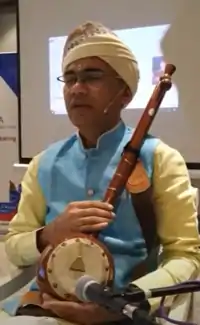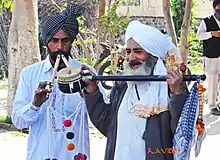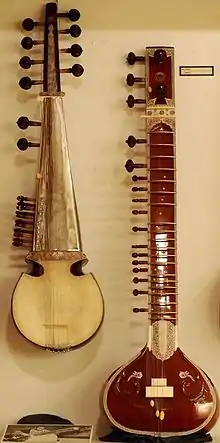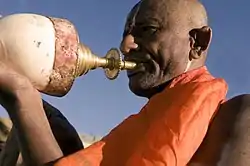Ektara
Ektara (Hindi: एकतारा, Urdu: اِک تارا, Bengali: একতারা, Nepali: एकतारे, Punjabi: ਇਕ ਤਾਰਾ, Tamil: எக்டரா; literally 'one-string', also called actara, iktar, ektar, yaktaro, gopichand, gopichant, golki Nepali: गोल्, gopijiantra, tun tuna) is a one-stringed musical instrument used in the traditional music of South Asia,[1] and used in modern-day music of Bangladesh, India, and Pakistan.[1] It originated in South Asia.[1]


In origin the ektara was a regular string instrument of wandering bards and minstrels from India and is plucked with one finger. The ektara is a drone lute consisting of a gourd resonator covered with skin, through which a bamboo neck is inserted. It is used in parts of India and Nepal today by Yogis and wandering holy men to accompany their singing and prayers. In Nepal, the instrument accompanies the singing of the Ramayana and Mahabharata.[2]
It has two forms. One form resembles a lute. To make that version, a bamboo stick (90cm long) is inserted through side of wooden bowl (called a "tumbo") and the top of the bowl is covered with deerskin. The instrument has a single string running from a peg at the top, down the length of the stick-neck, across a bridge on the deerhide soundboard, and is tied at the "spike" where the stick pokes through the bowl. The instrument's string is plucked with the musicians index fingernail.[3][2]
The other version uses a drum-like body, and a skin soundboard with a string attached (to bend the sound of the soundboard). Two bamboo lathes are attached to the side of the drumhead and the string goes from the soundboard to where the lathes meet. This version of the instrument may be played either by plucking the string or by tapping the drumhead. Squeezing and releasing the bamboo lathes puts pressure on the drumhead and bends the pitch up and down. This form is associated with the Bauls of West Bengal, as well as the Tharu people of Udayapur District, Nepal.
Performance
The ektārā player holds the instrument upright, gripping the neck just above the resonator and plucking the playing string or strings with the index finger of the same hand. If dancing, the player supports the gourd resonator with the other hand, in which clusters of small bells are carried, which sound while beating this hand against the gourd.[4] Pressing the two halves of the neck together loosens the string, thus lowering its pitch. The modulation of the tone with each slight flexing of the neck gives the ektara its distinctive sound. There are no markings or measurements to indicate what pressure will produce what note, so the pressure is adjusted by ear.[5] The various sizes of ektara are soprano, tenor, and bass. The bass ektara, sometimes called a dotara often has two strings[6] (as literally implied by do, 'two').
Use
The ektara is a common instrument in Baul music from Bengal. Some controversy has arisen in recent years over the adoption and alleged corruption of Baul music by popular bands and films in Bengal. It has become common to mix traditional instruments like the ektara with more modern sounds in an attempt to appeal to a wide audience, which according to Purna Das Baul is "destroying the true beauty" of Baul music.[7]
Gallery




 Photographer labeled photo "Ektara", location unknown.
Photographer labeled photo "Ektara", location unknown.
References
- Dilip Ranjan Barthakur (2003). The Music and Musical Instruments of North Eastern India. Mittal Publications. pp. 129–. ISBN 978-81-7099-881-5.
- Kadel, Ram Prasad (2007). Musical Instruments of Nepal. Katmandu, Nepal: Nepali Folk Instrument Museum. pp. 220, 229. ISBN 978-9994688302.
- "Photo Gallery". Kathmandu: Nepali Folk Musical Instrument Museum.
- "Ektar". Oxford Music Online. Retrieved 2014-09-18.
- "Ektara". Musical Instruments Archives. Archived from the original on 2014-09-08. Retrieved 2014-09-15.
- Lillian Henry. "What is Kirtan Music". Entertainment Scene 360. Archived from the original on 2014-07-01. Retrieved 2014-09-17.
- "Baul Songs - From Ektara to Fusion Music". INdo-Asian News Service. 2011. Retrieved 2014-09-24.
- "Kirtan". Dictionary.com. Retrieved 2014-09-16.
- "Stringed Instruments". Gandharva Loka. Retrieved 2014-09-16.




